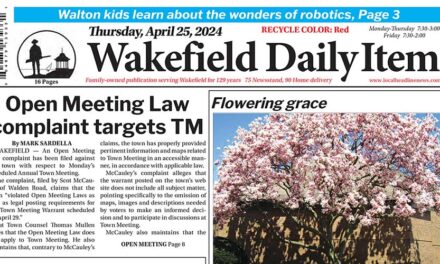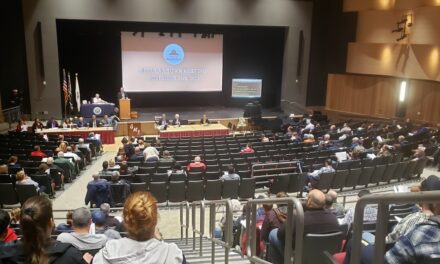By GAIL LOWE
WAKEFIELD — Grab your remote and fast forward to year 2025. Now zoom in to the workplace of the future, and what do you see?
If you envision rows upon rows of men and women seated in front of computers and other electronic devices — even robots — then your sight is a perfect 20/20. Today’s computers are the equivalent of the 19th century weaving loom.
As you read this, schools across the country are taking major steps to ensure that students are well prepared to continue their studies as they apply to STEAM (Science, Technology, Engineering, Art and Math).
Assistant Superintendent of Schools Dr. Kim Smith took time out of her workday last week to speak about the workplace of the future and how Wakefield is joining the STEAM stampede so students in the school district will not be left behind when they venture off to college or enter a career where they will be expected to have STEAM expertise.
Economic planners, policymakers, business leaders and, most importantly, educators have issued the call to improve STEM (or, as it is known in Wakefield, STEAM) education. To further Wakefield’s goals toward the new STEM state standards that will take effect in 2016, Dr. Smith and Wakefield Memorial High School Principal Richard Metropolis have formed a task force comprised of teachers, parents and businesses. Such a task force to move STEAM forward is sorely needed since the U.S. has moved from a manufacturing-based economy to one that is based on information and services. Superintendent of Schools Dr. Stephen K. Zrike stands firmly behind the STEAM drive.
The first task force meeting will be held April 2 at 7 p.m. in the Galvin Middle School Learning Commons.
(Those interested in participating should contact Smith by March 20 at kim.smith@wpsk.12.org.)
Brainstorming sessions are currently being held on Wakefield’s STEAM movement.
Dr. Smith said she, along with Metropolis and Dr. Zrike and other administrators, are aiming for more “robust offerings” of STEAM curriculum in the schools, starting as early as first grade and ending at grade 12.
Dr. Smith said that students in Wakefield are “showing a lot of interest.”
“Last year, we offered a computer programming class,” she said. “Students learned computer programming through game design and it was a good hook (to pull them in). Many signed up, so we had to run multiple sections of the course.”
In grade 6, students are learning about Automation and Robotics in Brian Addesa’s class. Other students are learning the basics of designing apps.
This year, Smith said art was added to STEAM because the town is known for its devotion to the arts. As an example, Wakefield offers a vibrant arts program in its schools, which includes drawing, painting, ceramics, illustration, black and white photography and TV production.
Establishing partnerships with businesses in the community is another major key to move STEAM along a steady continuum, said Smith. Business owners and managers can offer real-world applications associated with lessons teachers need to provide.
A school and business collaboration can also provide teacher support, student mentoring and classroom resources. Through exposure to actual businesses, students can see the value in what they are learning in terms of their own life success and, ultimately, the success of the country.
Dr. Smith said that the two biggest pieces of STEAM learning are innovation and design. The backbone of economic growth in the U.S. relies on engineering innovation but engineering innovation cannot happen without engineers and scientists. Some students struggle with engineering design processes or the vast field of engineering.
As a result, many lose interest in math and do not pursue STEM fields. Some school districts are sponsoring projects to enhance the knowledge of teachers about engineering innovation and design to empower them to provide students inspirational engineering and innovation experiences as well as better inform their students of potential career fields and societal needs.
According to a report released by the Committee for Economic Development, a non-profit, non-partisan business-led public policy agency that supports schools and business partnerships that prepare tomorrow’s American workforce and supports towns like Wakefield, students in the U.S. in all age groups are being outperformed on assessments of STEM subjects by students across Asia and Europe.
The trend is alarming to educators and places the future of American students in jeopardy.
To quote Arne Duncan, U.S. secretary of education, “The challenge for our education system is to leverage the learning sciences and modern technology to create engaging, relevant and personalized learning experiences for all students that mirror their daily lives and the reality of their futures.”
The Ford Motor Company has stepped up to the plate by offering students the Driving Skills for Life Program, one which is part of Ford’s longstanding commitment to teen driver safety.
Even NASCAR has joined the effort through hands-on activities and driver integration. NASCAR and schools showcased how STEM and teamwork come alive outside the classroom in sports and potential careers in a 10-week interactive program.
“It’s been an interesting conversation,” said Smith about STEAM. “STEAM education needs to evolve with the opportunities and demands of the workforce; we clearly need to prepare our kids for career and college.
“It’s a burgeoning field,” said Smith. “We want to build on what we have. The interest is definitely there.”




